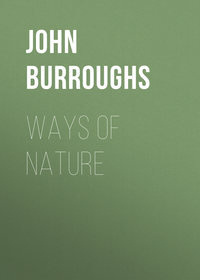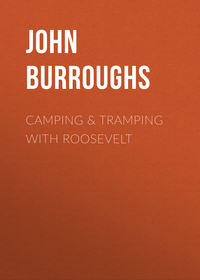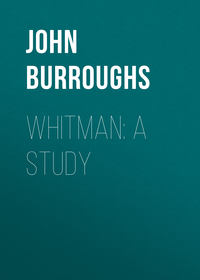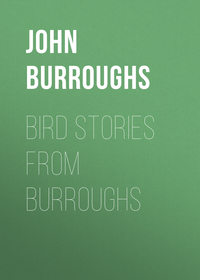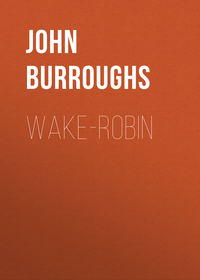 полная версия
полная версияRiverby
The new cavity which downy is now drilling is just above the old one and near the top of the stub. Its wells are usually sunk to a depth of six or eight inches, but in the present case it cannot be sunk more than four inches without breaking through into the old cavity. Downy seems to have considered the situation, and is proceeding cautiously. As she passed last night in her new quarters I am inclined to think it is about finished, and there must be at least one inch of wood beneath her. She worked vigorously the greater part of the day, her yellow chips strewing the snow beneath. I paused several times to observe her proceedings. After her chips accumulate she stops her drilling and throws them out. This she does with her beak, shaking them out very rapidly with a flirt of her head. She did not disappear from sight each time to load her beak, but withdrew her head and appeared to seize the fragments as if from her feet. If she had had a companion I should have thought he was handing them up to her from the bottom of the cavity. Maybe she had them piled up near the doorway.
The woodpeckers, both the hairy and the downy, usually excavate these winter retreats in the fall. They pass the nights and the stormy days in them. So far as I have observed, they do not use them as nesting-places the following season. Last night when I rapped on the trunk of the old apple-tree near sundown, downy put out her head with a surprised and inquiring look, and then withdrew it again as I passed on.
I have spoken of the broods of the great crested flycatchers that have been reared in the old apple-tree. This is by no means a common bird, and as it destroys many noxious insects I look upon it with a friendly eye, though it is the most uncouth and unmusical of the flycatchers. Indeed, among the other birds of the garden and orchard it seems quite like a barbarian. It has a harsh, froglike scream, form and manners to suit, and is clad in a suit of butternut brown. It seeks a cast-off snakeskin to weave into its nest, and not finding one, will take an onion skin, a piece of oiled paper, or large fish scales. It builds in a cavity in a tree, rears one brood, and is off early in the season. I never see or hear it after August 1st.
A pair have built in a large, hollow limb in my old apple-tree for many years. Whether it is the same pair or not I do not know. Probably it is, or else some of their descendants. I looked into the cavity one day while the mother bird was upon the nest, but before she had laid any eggs. A sudden explosive sound came up out of the dark depths of the limb, much like that made by an alarmed cat. It made me jerk my head back, when out came the bird and hurried off. For several days I saw no more of the pair, and feared they had deserted the spot. But they had not; they were only more sly than usual. I soon discovered an egg in the nest, and then another and another.
One day, as I stood near by, a male bluebird came along with his mate, prospecting for a spot for a second nest. He alighted at the entrance of this hole and peeped in. Instantly the flycatcher was upon him. The blue was enveloped by the butternut brown. The two fell to the ground, where the bluebird got away, and in a moment more came back and looked in the hole again, as much as to say, "I will look into that hole now at all hazards." The barbarian made a dash for him again, but he was now on his guard and avoided her.
Not long after, the bluebirds decided to occupy the old cavity of the downy woodpecker from which I had earlier in the season expelled the English sparrows. After they had established themselves here a kind of border war broke out between the male bluebird and the flycatchers, and was kept up for weeks. The bluebird is very jealous and very bold. He will not even tolerate a house wren in the vicinity of his nest. Every bird that builds in a cavity he looks upon as his natural rival and enemy. The flycatchers did not seek any quarrel with him as long as he kept to his own domicile, but he could not tolerate them in the same tree. It was a pretty sight to see this little blue-coat charging the butternut through the trees. The beak of the latter would click like a gunlock, and its harsh, savage voice was full of anger, but the bluebird never flinched, and was always ready to renew the fight.
The English sparrow will sometimes worst the bluebird by getting possession of the box or cavity ahead of him. Once inside, the sparrow can hold the fort, and the bluebird will soon give up the siege; but in a fair field and no favor, the native bird will quickly rout the foreigner.
Speaking of birds that build in cavities reminds me of a curious trait the high-hole has developed in my vicinity, one which I have never noticed or heard of elsewhere. It drills into buildings and steeples and telegraph poles, and in some instances makes itself a serious nuisance. One season the large imitation Greek columns of an unoccupied old-fashioned summer residence near me were badly marred by them. The bird bored into one column, and finding the cavity – a foot or more across – not just what it was looking for, cut into another one, and still into another. Then he bored into the ice-house on the premises, and in the sawdust filling between the outer and inner sheathing found a place to his liking. One bird seemed like a monomaniac, and drilled holes up and down and right and left as if possessed of an evil spirit. It is quite probable that if a high-hole or other woodpecker should go crazy, it would take to just this sort of thing, drilling into seasoned timber till it used its strength up. The one I refer to would cut through a dry hemlock board in a very short time, making the slivers fly. The sound was like that of a carpenter's hammer. It may have been that he was an unmated bird, a bachelor whose suit had not prospered that season, and who was giving vent to his outraged instincts in drilling these mock nesting-places.
XVII
THE WAYS OF SPORTSMEN
I have often had occasion to notice how much more intelligence the bird carries in its eye than does the animal or quadruped. The animal will see you, too, if you are moving, but if you stand quite still even the wary fox will pass within a few yards of you and not know you from a stump, unless the wind brings him your scent. But a crow or a hawk will discern you when you think yourself quite hidden. His eye is as keen as the fox's sense of smell, and seems fairly to penetrate veils and screens. Most of the water-fowl are equally sharp-eyed. The chief reliance of the animals for their safety, as well as for their food, is upon the keenness of their scent, while the fowls of the air depend mainly upon the eye.
A hunter out in Missouri relates how closely a deer approached him one day in the woods. The hunter was standing on the top of a log, about four feet from the ground, when the deer bounded playfully into a glade in the forest, a couple of hundred yards away. The animal began to feed and to move slowly toward the hunter. He was on the alert, but did not see or scent his enemy. He never took a bite of grass, says the sportsman, without first putting his nose to it, and then instantly raising his head and looking about.
In about ten minutes the deer had approached within fifty yards of the gunner; then the murderous instinct of the latter began to assert itself. His gun was loaded with fine shot, but he dared not make a move to change his shells lest the deer see him. He had one shell loaded with No. 4 shot in his pocket. Oh! if he could only get that shell into his gun.
The unsuspecting deer kept approaching; presently he passed behind a big tree, and his head was for a moment hidden. The hunter sprang to his work; he took one of the No. 8 shells out of his gun, got his hand into his pocket, and grasped the No. 4. Then the shining eyes of the deer were in view again. The hunter stood in this attitude five minutes. How we wish he had been compelled to stand for five hundred!
Then another tree shut off the buck's gaze for a moment; in went the No. 4 shell into the barrel and the gun was closed quickly, but there was no time to bring it to the shoulder. The animal was now only thirty yards away. His hair was smooth and glossy, and every movement was full of grace and beauty. Time after time he seemed to look straight at the hunter, and once or twice a look of suspicion seemed to cross his face.
The man began to realize how painful it was to stand perfectly still on the top of a log for fifteen minutes. Every muscle ached and seemed about to rebel against his will. If the buck held to his course he would pass not more than fifteen feet to one side of the gun, and the man that held it thought he might almost blow his heart out.
There was one more tree for him to pass behind, when the gun could be raised. He approached the tree, rubbed his nose against it, and for a moment was half hidden behind it. When his head appeared on the other side the gun was pointed straight at his eye – and with only No. 4 shot, which could only wound him, but could not kill him.
The deer stops; he does not expose his body back of the fore leg, as the hunter had wished. The latter begins to be ashamed of himself, and has about made up his mind to let the beautiful creature pass unharmed, when the buck suddenly gets his scent, his head goes up, his nostrils expand, and a look of terror comes over his face. This is too much for the good resolutions of the hunter. Bang! goes the gun, the deer leaps into the air, wheels around a couple of times, recovers himself and is off in a twinkling, no doubt carrying, the narrator says, a hundred No. 4 shot in his face and neck. The man says: "I've always regretted shooting at him."
I should think he would. But a man in the woods, with a gun in his hand, is no longer a man – he is a brute. The devil is in the gun to make brutes of us all.
If the game on this occasion had been, say a wild turkey or a grouse, its discriminating eye would have figured out the hunter there on that log very quickly. This manly exploit of the Western hunter reminds me of an exploit of a Brooklyn man, who last winter killed a bull moose in Maine. It was a more sportsmanlike proceeding, but my sympathies were entirely with the moose. The hero tells his story in a New York paper. With his guides, all armed with Winchester rifles, he penetrated far into the wilderness till he found a moose yard. It was near the top of a mountain. They started one of the animals and then took up its trail. As soon as the moose found it was being followed, it led right off in hopes of outwalking its enemies. But they had snow-shoes and he did not; they had food and he did not. On they went, pursued and pursuers, through the snow-clogged wilderness, day after day. The moose led them the most difficult route he could find.
At night the men would make camp, build a fire, eat and smoke, and roll themselves in their blankets and sleep. In the morning they would soon come up to the camping-place of the poor moose, where the imprint of his great body showed in the snow, and where he had passed a cold, supperless night.
On the fifth day the moose began to show signs of fatigue; he rested often, he also tried to get around and behind his pursuers and let them pass on. Think how inadequate his wit was to cope with the problem – he thought they would pass by him if he went to one side.
On the morning of the sixth day he had made up his mind to travel no farther, but to face his enemies and have it out with them. As he heard them approach, he rose up from his couch of snow, mane erect, his look fierce and determined. Poor creature, he did not know how unequal the contest was. How I wish he could at that moment have had a Winchester rifle, too, and had known how to use it. There would have been fair play then. With such weapons as God had given him he had determined to meet the foe, and if they had had only such weapons as God had given them, he would have been safe. But they had weapons which the devil had given them, and their deadly bullets soon cut him down, and now probably his noble antlers decorate the hall of his murderer.
XVIII
TALKS WITH YOUNG OBSERVERS
ITo teach young people or old people how to observe nature is a good deal like trying to teach them how to eat their dinner. The first thing necessary in the latter case is a good appetite; this given, the rest follows very easily. And in observing nature, unless you have the appetite, the love, the spontaneous desire, you will get little satisfaction. It is the heart that sees more than the mind. To love Nature is the first step in observing her. If a boy had to learn fishing as a task, what slow progress he would make; but as his heart is in it, how soon he becomes an adept.
The eye sees quickly and easily those things in which we are interested. A man interested in horses sees every fine horse in the country he passes through; the dairyman notes the cattle; the bee culturist counts the skips of bees; the sheep-grower notes the flocks, etc. Is it any effort for the ladies to note the new bonnets and the new cloaks upon the street? We all see and observe easily in the line of our business, our tasks, our desires.
If one is a lover of the birds, he sees birds everywhere, plenty of them. I think I seldom miss a bird in my walk if he is within eye or ear shot, even though my mind be not intent upon that subject. Walking along the road this very day, feeling a cold, driving snow-storm, I saw some large birds in the top of a maple as I passed by. I do not know how I came to see them, for I was not in an ornithological frame of mind. But I did. There were three of them feeding upon the buds of the maple. They were nearly as large as robins, of a dark ash-color, very plump, with tails much forked. What were they? My neighbor did not know; had never seen such birds before. I instantly knew them to be pine grosbeaks from the far north. I had not seen them before for ten years. A few days previously I had heard one call from the air as it passed over; I recognized the note, and hence knew that the birds were about. They come down from the north at irregular intervals, and are seen in flocks in various parts of the States. They seem just as likely to come mild winters as severe ones. Later in the day the birds came about my study. I sat reading with my back to the window when I was advised of their presence by catching a glimpse of one reflected in my eye-glasses as it flew up from the ground to the branch of an apple-tree only a few feet away. I only mention the circumstance to show how quick an observer is to take the hint. I was absorbed in my reading, but the moment that little shadow flitted athwart that luminous reflection of the window in the corner of my glasses, something said "that was a bird." Approaching the window, I saw several of them sitting not five feet away. I could inspect them perfectly. They were a slate-color, with a tinge of bronze upon the head and rump. In full plumage the old males are a dusky red. Hence these were all either young males or females. Occasionally among these flocks an old male may be seen. It would seem as if only a very few of the older and wiser birds accompanied these younger birds in their excursions into more southern climes.
Presently the birds left the apple-bough that nearly brushed my window, and, with a dozen or more of their fellows that I had not seen, settled in a Norway spruce a few yards away, and began to feed upon the buds. They looked very pretty there amid the driving snow. I was flattered that these visitants from the far north should find entertainment on my premises. How plump, contented, and entirely at home they looked. But they made such havoc with the spruce buds that after a while I began to fear not a bud would be left upon the trees; the spruces would be checked in their growth the next year. So I presently went out to remonstrate with them and ask them to move on. I approached them very slowly, and when beside the tree within a few feet of several of them, they heeded me not. One bird kept its position and went on snipping off the buds till I raised my hand ready to seize it, before it moved a yard or two higher up. I think it was only my white, uncovered hand that disturbed it. Indeed,
"They were so unacquainted with man,Their tameness was shocking to me."The snow was covered with the yellow chaffy scales of the buds and still the birds sifted them down, till I was compelled to "shoo" them away, when they moved to a tree nearer the house beneath which they left more yellow chaff upon the snow.
The mind of an observer is like a gun with a hair trigger – it goes at a touch, while the minds of most persons require very vigorous nudging. You must take the hint and take it quickly if you would get up any profitable intimacy with nature. Above all, don't jump to conclusions; look again and again; verify your observations. Be sure the crow is pulling corn, and not probing for grubs, before you kill him. Be sure it is the oriole purloining your grapes, and not the sparrows, before you declare him your enemy. I one day saw hummingbirds apparently probing the ripe yellow cheeks of my finest peaches, but I was not certain till I saw a bird hovering over a particular peach, and then mounting upon a ladder I examined it, when sure enough, the golden cheek was full of pin-holes. The orioles destroy many of my earliest pears, but it required much watching to catch them in the very act. I once saw a phœbe-bird swoop down upon a raspberry bush and carry a berry to a rail on a near fence, but I did not therefore jump to the conclusion that the phœbe was a berry-eater. What it wanted was the worm in the berry. How do I know? Because I saw it extract something from the berry and fly away.
A French missionary, said to have been a good naturalist, writing in this country in 1634, makes this curious statement about our hummingbird: "This bird, as one might say, dies, or, to speak more correctly, puts itself to sleep in the month of October, living fastened to some little branchlet of a tree by the feet, and wakes up in the month of April when the flowers are in abundance, and sometimes later, and for that cause is called in the Mexican tongue the 'Revived.'" How could the good missionary ever have been led to make such a statement? The actual finding of the bird wintering in that way would have been the proof science demands, and nothing short of that.
A boy in the interior of the State wrote to me the other day that while in the field looking after Indian arrow-heads he had seen a brown and gray bird with a black mark running through the eye, and that the bird walked instead of hopped. He said it had a high, shrill whistle and flew like a meadowlark. This boy is a natural observer; he noted that the bird was a walker. Most of the birds hop or jump, keeping both feet together. This boy heard his bird afterward in the edge of the evening, and "followed it quite a ways, but could not get a glimpse of it." He had failed to note the crest on its head and the black spot on its breast, for doubtless his strange bird was the shore lark, a northern bird, that comes to us in flocks in the late fall or early winter, and in recent years has become a permanent resident of certain parts of New York State. I have heard it in full song above the hills in Delaware County, after the manner of the English skylark, but its song was a crude, feeble, broken affair compared with that of the skylark. These birds thrive well in confinement. I had one seven months in a cage while living in Washington. It was disabled in the wing by a gunner, who brought it to me. Its wound soon healed; it took food readily; it soon became tame, and was an object of much interest and amusement. The cage in which I had hastily put it was formerly a case filled with stuffed birds. Its front was glass. As it was left out upon the porch over night, a strange cat discovered the bird through this glass, and through the glass she plunged and captured the bird. In the morning there was the large hole in this glass, and the pretty lark was gone. I have always indulged a faint hope that the glass was such a surprise to the cat, and made such a racket about her eyes and ears as she sprang against it, that she beat a hasty retreat, and that the bird escaped through the break.
IIIn May two boys in town wrote to me to explain to them the meaning of the egg-shells, mostly those of robins, that were to be seen lying about on the ground here and there. I supposed every boy knew where most of these egg-shells came from. As soon as the young birds are out, the mother bird removes the fragments of shells from the nest, carrying them in her beak some distance, and dropping them here and there. All our song-birds, so far as I know, do this.
Sometimes, however, these shells are dropped by blue jays after their contents have been swallowed. The jay will seize a robin's egg by thrusting his beak into it, and hurry off lest he be caught in the act by the owner. At a safe distance he will devour the contents at his leisure, and drop the shell.
The robins, however, have more than once caught the jay in the act. He has the reputation among them of being a sneak thief. Many and many a time during the nesting season you may see a lot of robins mob a jay. The jay comes slyly prowling through the trees, looking for his favorite morsel, when he is discovered by a vigilant robin, who instantly rushes at him crying, "Thief! thief!" at the top of his voice. All the robins that have nests within hearing gather to the spot and join in the pursuit of the jay, screaming and scolding.
The jay is hustled out of the tree in a hurry, and goes sneaking away with the robins at his heels. He is usually silent, like other thieves, but sometimes the birds make it so hot for him that he screams in anger and disgust.
Of the smaller birds, like the vireos and warblers, the jay will devour the young. My little boy one day saw a jay sitting beside a nest in a tree, probably that of the red-eyed vireo, and coolly swallowing the just hatched young, while the parent birds were powerless to prevent him. They flew at him and snapped their beaks in his face, but he heeded them not. A robin would have knocked him off his feet at her first dive.
One is sometimes puzzled by seeing a punctured egg lying upon the ground. One day I came near stepping upon one that was lying in the path that leads to the spring – a fresh egg with a little hole in it carefully placed upon the gravel. I suspected it to be the work of the cowbird, and a few days later I had convincing proof that the cowbird is up to this sort of thing. I was sitting in my summer house with a book, when I had a glimpse of a bird darting quickly down from the branches of the maple just above me toward the vineyard, with something in its beak. Following up my first glance with more deliberate scrutiny, I saw a female cowbird alight upon the ground and carefully deposit some small object there, and then, moving a few inches away, remain quite motionless. Without taking my eyes from the spot, I walked straight down there. The bird flew away, and I found the object she had dropped to be a little speckled bird's egg still warm. I saw that it was the egg of the red-eyed vireo. It was punctured with two holes where the bird had seized it; otherwise it had been very carefully handled. For some days I had been convinced that a pair of vireos had a nest in my maple, but much scrutiny had failed to reveal it to me.
Only a few moments before the cowbird appeared I had seen the happy pair leave the tree together, flying to a clump of trees lower down the slope of the hill. The female had evidently just deposited her egg, the cowbird had probably been watching near by, and had seized it the moment the nest was vacated. Her plan was of course to deposit one of her own in its place.
I now made a more thorough search for the nest, and soon found it, but it was beyond my reach on an outer branch, and whether or not the cowbird dropped one of her own eggs in place of the one she had removed I do not know. Certain am I that the vireos soon abandoned the nest, though they do not always do this when hoodwinked in this way.
I once met a gentleman on the train who told me about a brood of quails that had hatched out under his observation. He was convinced that the mother quail had broken the shells for the young birds. He sent me one of the shells to convince me that it had been broken from the outside. At first glance it did appear so. It had been cut around near the large end, with the exception of a small space, as if by regular thrusts or taps from a bird's beak, so that this end opened like the lid of a box on a hinge, and let the imprisoned bird escape. What convinced the gentleman that the force had been applied from the outside was that the edges of the cut or break were bent in.


